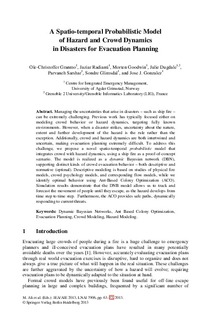| dc.contributor.author | Granmo, Ole-Christoffer | |
| dc.contributor.author | Radianti, Jaziar | |
| dc.contributor.author | Goodwin, Morten | |
| dc.contributor.author | Dugdale, Julie | |
| dc.contributor.author | Sarshar, Parvaneh | |
| dc.contributor.author | Glimsdal, Sondre | |
| dc.contributor.author | Gonzalez, Jose J. | |
| dc.date.accessioned | 2014-01-17T09:17:11Z | |
| dc.date.available | 2014-01-17T09:17:11Z | |
| dc.date.issued | 2013 | |
| dc.identifier.citation | Granmo, O.-C., Radianti, J., Goodwin, M., Dugdale, J., Sarshar, P., Glimsdal, S., & Gonzalez, J. J. (2013). A spatio-temporal probabilistic model of hazard and crowd dynamics in disasters for evacuation planning. In M. Ali, T. Bosse, K. Hindriks, M. Hoogendoorn, C. Jonker & J. Treur (Eds.), Recent Trends in Applied Artificial Intelligence (Vol. 7906, pp. 63-72): Springer. | no_NO |
| dc.identifier.isbn | 978-3-642-38576-6 | |
| dc.identifier.uri | http://hdl.handle.net/11250/138020 | |
| dc.description | Published version of a chapter in the book: Recent Trends in Applied Artificial Intelligence. Also available from the publisher at: http://dx.doi.org/10.1007/978-3-642-38577-3_7 | no_NO |
| dc.description.abstract | Managing the uncertainties that arise in disasters – such as ship fire – can be extremely challenging. Previous work has typically focused either on modeling crowd behavior or hazard dynamics, targeting fully known environments. However, when a disaster strikes, uncertainty about the nature, extent and further development of the hazard is the rule rather than the exception. Additionally, crowd and hazard dynamics are both intertwined and uncertain, making evacuation planning extremely difficult. To address this challenge, we propose a novel spatio-temporal probabilistic model that integrates crowd with hazard dynamics, using a ship fire as a proof-of-concept scenario. The model is realized as a dynamic Bayesian network (DBN), supporting distinct kinds of crowd evacuation behavior – both descriptive and normative (optimal). Descriptive modeling is based on studies of physical fire models, crowd psychology models, and corresponding flow models, while we identify optimal behavior using Ant-Based Colony Optimization (ACO). Simulation results demonstrate that the DNB model allows us to track and forecast the movement of people until they escape, as the hazard develops from time step to time step. Furthermore, the ACO provides safe paths, dynamically responding to current threats. | no_NO |
| dc.language.iso | eng | no_NO |
| dc.publisher | Springer | no_NO |
| dc.relation.ispartofseries | Lecture Notes in Computer Science;7906 | |
| dc.subject | dynamic Bayesian networks | no_NO |
| dc.subject | ant based colony optimization | no_NO |
| dc.subject | evacuation planning | no_NO |
| dc.subject | crowd modeling | no_NO |
| dc.subject | hazard modeling | no_NO |
| dc.title | A spatio-temporal probabilistic model of hazard and crowd dynamics in disasters for evacuation planning | no_NO |
| dc.type | Chapter | no_NO |
| dc.type | Peer reviewed | no_NO |
| dc.subject.nsi | VDP::Mathematics and natural science: 400::Mathematics: 410::Statistics: 412 | no_NO |
| dc.source.pagenumber | 63-72 | no_NO |
| dc.identifier.doi | 10.1007/978-3-642-38577-3_7 | |
